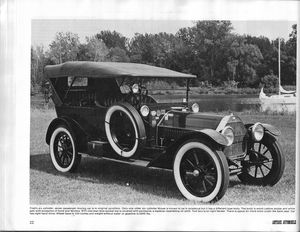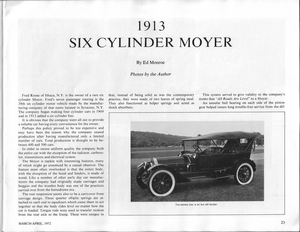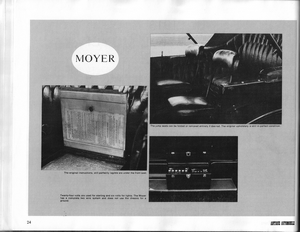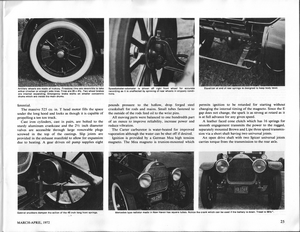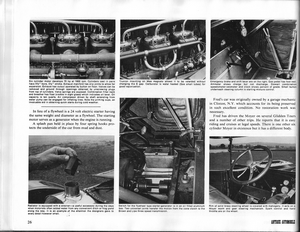|
By accessing or using The Crittenden Automotive Library™/CarsAndRacingStuff.com, you signify your agreement with the Terms of Use on our Legal Information page. Our Privacy Policy is also available there. |

1913 Six Cylinder Moyer
|
|---|
|
|
1913 Six Cylinder Moyer
Ed Monroe
Antique Automobile
March-April 1972
Photos by the author.
Fred Rouse of Ithaca, N.Y. is the owner of a rare six cylinder Moyer. Fred's seven passenger touring is the 38th six cylinder motor vehicle made by the manufacturing company of that name located in Syracuse, N.Y. The company began making four cylinder cars in 1909 and in 1913 added a six cylinder line.
It is obvious that the company went all out to provide a reliable car having every convenience for the owner.
Perhaps this policy proved to be too expensive and may have been the reason why the company ceased production after having manufactured only a limited number of cars. Total production is thought to be between 400 and 500 cars.
In order to insure uniform quality the company built the entire car with the exception of the radiator, carburetor, transmission and electrical system.
The Moyer is replete with interesting features, many of which might go unnoticed by a casual observer. The feature most often overlooked is that the entire body, with the exception of the hood and fenders, is made of wood. Like a number of other early day car manufacturers the company had originally made carriages and buggies and the wooden body was one of the practices carried over from the horsedrawn era.
The rear suspension seems also to be a carryover from carriage design. Three quarter elliptic springs are attached to each end to equalizers which cause them to act together so that the body rides level no matter how the car is loaded. Torque rods were used to transfer motion from the rear axle to the frame. These were unique in that, instead of being solid as was the contemporary practice, they were made of two leaves of spring steel. They also functioned as helper springs and acted as shock absorbers.
This system served to give validity to the company's
All Roads Are Level to a Moyer.
An annular ball bearing on each side of the pinion gear helped insure long trouble-free service from the differential.
The massive 525 cu. in. T head motor fills the space under the long hood and looks as though it is capable of propelling a ten ton truck.
Cast iron cylinders, cast in pairs, are bolted to the sturdy aluminum crankcase and the 2½ inch diameter valves are accessible through large removable plugs screwed in the top of the castings. Slip joints are provided in the exhaust manifold to allow for expansion due to heating. A gear driven oil pump supplies eight pounds pressure to the hollow, drop forged steel crankshaft for rods and mains. Small tubes fastened to the outside of the rods feed oil to the wrist pins.
All moving parts were balanced to one hundredth part of an ounce to improve reliability, increase power and reduce vibration.
The Carter carburetor is water-heated for improved vaporation although the water can be shut off if desired.
Ignition is provided by a German Mea high tension magneto. The Mea magneto is trunion-mounted which permits ignition to be retarded for starting without changing the internal timing of the magneto. Since the E gap does not change, the spark is as strong at retard as it is at full advance for any given speed.
A leather faced cone clutch which has 16 springs for smooth engagement transmits power to the rugged, separately mounted Brown and Lipe three speed transmission via a short shaft having two universal joints.
An open drive shaft with two Spicer universal joints carries torque from the transmission to the rear axle.
In lieu of a flywheel is a 24 volt electric starter having the same weight and diameter of a flywheel. The starting motor serves as a generator when the engine is running.
A splash pan held in place by four spring hooks protects the underside of the car from mud and dust.
Fred's car was originally owned by a garage mechanic in Clinton, N.Y. which accounts for its being preserved in such excellent condition. No restoration work was necessary.
Fred has driven the Moyer on several Glidden Tours and a number of other trips. He reports that it is easy riding and cruises at legal speeds. There is one other six cylinder Moyer in existence but it has a different body.


















